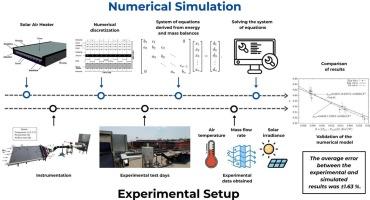Numerical modelling of back-pass triangular solar air heaters and its experimental validation. Comparison against different geometries
IF 6
2区 工程技术
Q2 ENERGY & FUELS
引用次数: 0
Abstract
A numerical model was developed to predict the instantaneous thermal efficiency, the incident angle modifier curves, and airflow humidity and temperature in the Solar Air Heaters (SAHs) with triangular ducts. The model applies the control volume method with discretization along both axial and longitudinal directions, incorporating empirical correlations to solve the resulting system of algebraic equations. Validation was performed using 24 instantaneous thermal efficiency data points specifically collected for this purpose, yielding an average error of ± 1.63 % between experimental and simulated results. Additionally, a weighted least-squares regression was conducted to compare experimental and numerical thermal efficiency values. These analyses demonstrate that the proposed model is a reliable tool for the design and optimization of back-pass SAHs with triangular duct geometries.
Additionally, an experimental comparison between SAHs with triangular and rectangular ducts constructed from the same materials revealed that triangular configurations are, on average, 3.73 % more efficient than rectangular ones. The comparison of instantaneous thermal efficiency curves of triangular SAHs with two distinct opening angles (60° and 90°) indicated that a 60° angle yields, on average, 9.35 % higher efficiency, and with an incident angle of 50°, the 60° configuration is approximately 3 % more efficient than the 90° angle.

背向三角形太阳能空气加热器的数值模拟及实验验证。不同几何形状的比较
建立了三角风管太阳能空气加热器的瞬时热效率、入射角修正曲线以及气流湿度和温度的数值模型。该模型采用沿轴向和纵向离散化的控制体积方法,结合经验相关性来求解所得到的代数方程系统。使用专门为此目的收集的24个瞬时热效率数据点进行验证,实验结果与模拟结果之间的平均误差为±1.63%。此外,采用加权最小二乘回归对实验热效率值和数值热效率值进行了比较。这些分析表明,所提出的模型是设计和优化具有三角形导管几何形状的回通SAHs的可靠工具。此外,用相同材料构造三角形和矩形管道的SAHs的实验比较表明,三角形结构的效率平均比矩形结构的效率高3.73%。对比两种不同开角(60°和90°)的三角形SAHs的瞬时热效率曲线表明,60°开角的效率平均提高9.35%,当入射角为50°时,60°开角的效率比90°开角的效率提高约3%。
本文章由计算机程序翻译,如有差异,请以英文原文为准。
求助全文
约1分钟内获得全文
求助全文
来源期刊

Solar Energy
工程技术-能源与燃料
CiteScore
13.90
自引率
9.00%
发文量
0
审稿时长
47 days
期刊介绍:
Solar Energy welcomes manuscripts presenting information not previously published in journals on any aspect of solar energy research, development, application, measurement or policy. The term "solar energy" in this context includes the indirect uses such as wind energy and biomass
 求助内容:
求助内容: 应助结果提醒方式:
应助结果提醒方式:


